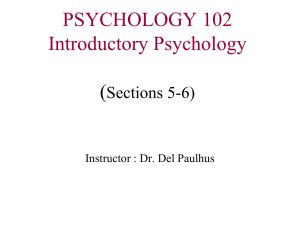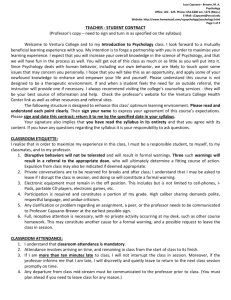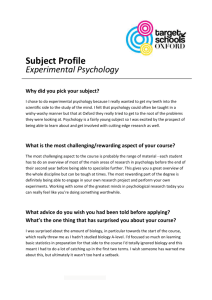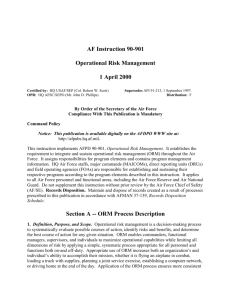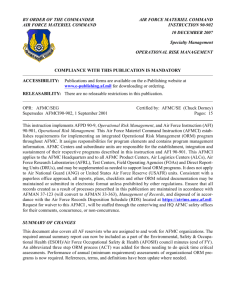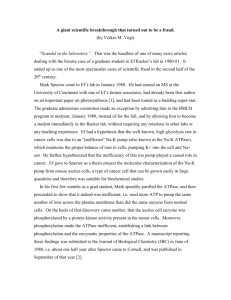Syllabus
advertisement
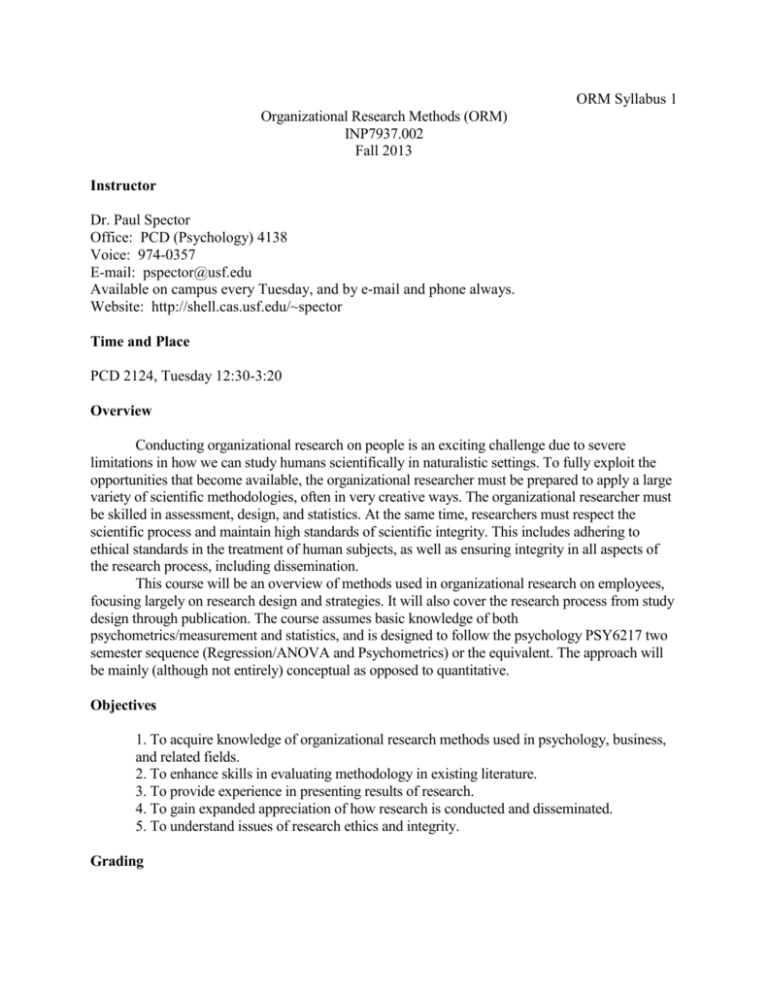
ORM Syllabus 1 Organizational Research Methods (ORM) INP7937.002 Fall 2013 Instructor Dr. Paul Spector Office: PCD (Psychology) 4138 Voice: 974-0357 E-mail: pspector@usf.edu Available on campus every Tuesday, and by e-mail and phone always. Website: http://shell.cas.usf.edu/~spector Time and Place PCD 2124, Tuesday 12:30-3:20 Overview Conducting organizational research on people is an exciting challenge due to severe limitations in how we can study humans scientifically in naturalistic settings. To fully exploit the opportunities that become available, the organizational researcher must be prepared to apply a large variety of scientific methodologies, often in very creative ways. The organizational researcher must be skilled in assessment, design, and statistics. At the same time, researchers must respect the scientific process and maintain high standards of scientific integrity. This includes adhering to ethical standards in the treatment of human subjects, as well as ensuring integrity in all aspects of the research process, including dissemination. This course will be an overview of methods used in organizational research on employees, focusing largely on research design and strategies. It will also cover the research process from study design through publication. The course assumes basic knowledge of both psychometrics/measurement and statistics, and is designed to follow the psychology PSY6217 two semester sequence (Regression/ANOVA and Psychometrics) or the equivalent. The approach will be mainly (although not entirely) conceptual as opposed to quantitative. Objectives 1. To acquire knowledge of organizational research methods used in psychology, business, and related fields. 2. To enhance skills in evaluating methodology in existing literature. 3. To provide experience in presenting results of research. 4. To gain expanded appreciation of how research is conducted and disseminated. 5. To understand issues of research ethics and integrity. Grading ORM Syllabus 2 Grades will be based on the project and presentations, as well as classroom participation. Missed Classes Students are expected to attend all classes. All missed classes must be made-up by writing a two page overview of the topic that was discussed that week. The overview is due the week immediately following the absence. It should be e-mailed to me. Readings Weekly Readings. Weekly readings, that form the bulk of the material for the class, are in the attached reading list. The schedule shows which readings will be discussed each week. Most are from the major journals, and can be found in the virtual library or online. Research Project There will be a research project involving the collection of data to test a hypothesis. Each student will develop a hypothesis involving 3 variables, choose measures for each variable, and collect survey data. Both a written report in journal article format and brief 5-6 minute presentation are required. Symposium-Style Presentations of Articles Each week students will do a 10 minute PowerPoint presentation of an article they choose that describes an organizational research study. The presentations should be like those in symposium sessions at a major conference. You should role-play as if you were the author of the particular paper. The presentation should clearly cover the purpose/rationale of the study, hypotheses (if any), method, results and conclusions. It might be necessary to simplify the study considering the time limitations. At the conclusion of the presentation, there will be questions of the presenter by the class, again similar to a conference. Each student will do two such presentations during the semester. The time limit must be adhered to, as part of this exercise is to get used to presenting conference papers in limited time. You will be cut off at 10 minutes. Article Analysis As you read content articles inside and outside of classes, you should pay attention to the methodology and the structure of arguments. At issue is the connection among design, measurement, statistics, and inference. By paying attention to how other authors handle these connections, it will help you develop your own research skills and write your own papers. One reason to volunteer to review papers for conferences and eventually journals is that critiquing the work of others helps you in your own work. Just always remember it is a lot easier to be a critic than an author. In particular, as you read articles pay attention to the following: 1. Purpose/rationale of the study. How do the authors setup the study? How do they position it? What is the contribution to the literature, i.e., what gaps does it address? ORM Syllabus 3 2. Theory. Does the paper provide a coherent theory or theoretical framework? Is it clear how the hypotheses are derived from theory or do authors just claim their hypothesis is supported? 3. Method. What is the design of the study? How are variables operationalized? Are measures reliable? Are measures established with strong evidence for construct validity? Is this a single-source or multi-source design? How were the data collected, i.e., what is the procedure? Are their ethical issues involved in the study? What population was sampled? What are the limitations to generalizability in both population and setting? 4. Results. How were the data analyzed? How were hypotheses tested? Did results support or fail to support hypotheses? Did analyses make sense? Were they overly complex? Did the authors give a good rationale for what they did? If complex statistics were used, were the simpler building blocks also shown/discussed such as descriptive statistics and correlations? 5. Discussion. What do the authors conclude? Do the conclusions flow logically from the method/results or are they stretched? Do you agree with the conclusions? Are there feasible alternative explanations for results? Were limitations discussed and if so, did you find this discussion to be informative/thoughtful or merely obvious? 6. General. Was the paper clearly written/presented and did it do a good job of communicating the results of the study? Class Sessions There will be 5 major activities that will take place in class. 1. Instructor lecture about methodology 2. Student symposium-style presentation of own articles 3. Discussion of weekly readings including asking questions of the instructor. 4. Work on research project 5. Student presentation of project (last week of class) Taping policy: Notes and tapes cannot be taken for the purpose of sale. ORM Syllabus 4 Schedule The schedule lists the topics, readings, and assignment due dates. Date 8/27 9/3 Topic Course Introduction Causality and control 9/10 9/17 9/24 10/1 10/8 10/15 10/22 10/29 11/5 11/12 11/19 12/26 Validity and threats to validity Construct and external validity Quasi-experiments Multi-level designs Longitudinal designs/Diary studies Field experiments Survey methods Theory Southern Management Association Statistics Meta-analysis and reviews Ethical/practical issues Reading/Assignment SCC-1, Meehl, Spector-Brannick, Stone-Romero 2008 SCC-2, Bones, Simmons, Yong SCC-3, Conway, Spector SCC-4, 5, Stone-Romero Hofmann, Tasa Fisher, Zapf Judd, Wainer, Bedeian Edwards 00, Spector VanKatwyk, Schaffer Edwards 10, Hambrick, Sutton Bedeian 09, Cortina, Lance 06, 11 Aguinis (2011), Schmidt Aguinis (2002), Estes, Simonsohn, Von Glinow, Papers due 12/3 Wrap-up Project presentations Note: SSC is the Shadish et al. book, and the numbers refer to chapters. ORM Syllabus 5 Readings Aguinis, H., & Henle, C. A. (2002). Ethics in Research. In S. G. Rogelberg (Ed.). Handbook of research methods in industrial and organizational psychology (pp. 34-56). Malden, MA: Blackwell. Aguinis, H., Pierce, C. A., Bosco, F. A., Dalton, D. R., & Dalton, C. M. (2011). Debunking myths and urban legends about meta-analysis. Organizational Research Methods, 14, 306-331. Bedeian, A. G. (1987). Of fiction and fraud: A comment on Barry and Elmes’ article. Academy of Management Review, 22, 840-842. Bedeian, A. G., Sturman, M. C., & Streiner, D. L. (2009). Decimal dust, significant digits, and the search for stars. Organizational Research Methods, 12, 687-694. Bones, A. K. (2012). We knew the future all along. Perspectives on Psychological Science, 7, 307-309. Conway, J. M., & Lance, C. E. (2010). What reviewers should expect from authors regarding common method bias in organizational research. Journal of Business and Psychology, 25, 325-334. Cortina, J. M., & Landis, R. S. (2011). The earth is not round (p = .00). Organizational Research Methods, 14, 332-349. Daft, R. L. (1983). Learning the craft of organizational research. Academy of Management Review, 8, 539-546. Edwards, J. R., & Bagozzi, R. P. (2000). On the nature and direction of relationships between constructs and measures. Psychological Methods, 5, 155-174. Edwards, J. R., & Berry, J. W. (2010). The presence of something or the absence of nothing: Increasing theoretical precision in management research. Organizational Research Methods, 13, 668-689. Estes, S. (2012). The myth of self-correcting science. The Atlantic. Accessed August 6, 2013 from http://www.theatlantic.com/health/archive/2012/12/the-myth-of-self-correctingscience/266228/#.UNNLECeREGQ.email Fisher, C. D., & To, M. L. (2012). Using experience sampling methodology in organizational behavior. Journal of Organizational Behavior, n/a-n/a. Hambrick, D. C. (2007). The field of management’s devotion to theory: Too much of a good ORM Syllabus 6 thing? Academy of Management Journal, 50, 1346-1352. Hofmann, D. A. (2002). Issues in multilevel research: Theory, development, measurement, and analysis. In S. G. Rogelberg (Ed.). Handbook of research methods in industrial and organizational psychology (pp. 247-274). Malden, MA: Blackwell. Judd, C. M., Smith, E. R., & Kidder, L. H. (1991). Research methods in social relations. 6th ed. Chapter 14 “Applied versus basic research”. Fort Worth, TX: Harcourt Brace Jovanovich. Lance, C. E. (2011). More statistical and methodological myths and urban legends. Organizational Research Methods, 14, 279-286. Lance, C. E., Butts, M. M., & Michels, L. C. (2006). The Sources of Four Commonly Reported Cutoff Criteria: What Did They Really Say? Organizational Research Methods, 9, 202220. Meehl, P. E. (1971). High school yearbooks: A reply to Schwarz. Journal of Abnormal Psychology, 77, 143-148. Schaffer, B. S., & Riordan, C. M. (2003). A review of cross-cultural methodologies for organizational research: A best-practices approach. Organizational Research Methods, 6, 169-215. Schmidt, F. L., & Hunter, J. E. (2001). Meta-analysis. In N. Anderson, D. S. Ones, H. K. Sinangil, & Viswesvaran, C. (Eds.). Handbook of industrial, work and organizational psychology, Volume 1. (pp. 51-70). Thousand Oaks, CA: Sage. Shadish, W. R., Cook, T. D., & Campbell, D. T. (2002). Experimental and quasi-experimental designs for generalized causal inference, Boston: Houghton Mifflin. [Chapters 1-5] Simmons, J. P., Nelson, L. D., & Simonsohn, U. (2011). False-positive psychology: Undisclosed flexibility in data collection and analysis allows presenting anything as significant. Psychological Science, 22, 1359-1366. Simonsohn, U. (2013). Just post it: The lesson from two cases of fabricated data detected by statistics alone. (January 29, 2013). Available at SSRN: http://ssrn.com/abstract=2114571. Spector, P. E. (2006). Method variance in organizational research: Truth or urban legend? Organizational Research Methods, 9, 221-232. Spector, P. E., & Brannick, M. T. (2011). Methodological urban legends: The misuse of statistical control variables. Organizational Research Methods, 14, 287-305. Spector, P. E., Van Katwyk, P. T., Brannick, M. T., & Chen, P. Y. (1997). When two factors ORM Syllabus 7 don’t reflect two constructs: How item characteristics can produce artifactual factors. Journal of Management, 23, 659-678. Stone-Romero, E. F. (2002). The relative validity and usefulness of various empirical research designs. In S. G. Rogelberg (Ed.). Handbook of research methods in industrial and organizational psychology (pp. 77-98). Malden, MA: Blackwell. Stone-Romero, E. F., & Rosopa, P. J. (2008). The relative validity of inferences about mediation as a function of research design characteristics. Organizational Research Methods, 11, 326-352. Sutton, R. I., & Staw, B. M. (1995). What theory is not. Administrative Science Quarterly, 40, 371-384. Tasa, K., Sears, G. J., & Schat, A. C. H. (2011). Personality and teamwork behavior in context: The cross-level moderating role of collective efficacy. Journal of Organizational Behavior, 32, 65-85. Von Glinow, M. A., & Novelli, L., Jr. (1982). Ethical standards within organizational behavior. Academy of Management Journal, 25, 417-436. Wainer, H. (1999). The most dangerous profession: A note on nonsampling error. Psychological Methods, 4, 250-256. Yong, E. (2012). Bad copy. Nature, 485, 298-300. Zapf, D., Dormann, C., & Frese, M. (1996). Longitudinal studies in organizational stress research: A review of the literature with reference to methodological issues. Journal of Occupational Health Psychology, 1, 145-169. Recommended Readings Outside of Class Bhattacharjee, Y. (2013, August 26). The mind of a con man. The New York Times Magazine. Accessed August 6, 2013 from here. Interview with Diederik Stapel. Campbell, D. T., & Fiske, D. W. (1959). Convergent and discriminant validation by the multitrait-multimethod matrix. Psychological Bulletin, 56, 81-105. Classic that introduced convergent/discriminant validity and method variance. Denzin, N. K., & Lincoln, Y. S. (Eds.) (1994). Handbook of qualitative research methods. Thousand Oaks, CA: Sage. Good overview of qualitative methods. Fields, D. L. (2002). Taking the measure of work: A guide to validated scales for organizational research and diagnosis. Thousand Oaks, CA: Sage. Has many useful scales. ORM Syllabus 8 Gopen, G. D., & Swan, J. A. (1990). The science of scientific writing. American Scientist, 78, 550-558. Great guide to clear writing. James, L. R., Demaree, R. G., & Wolf, G. (1993). Rwg: An assessment of within-group agreement. Journal of Applied Psychology, 78, 306-309. Good explanation of one of the major measures of agreement. Klein, K. J., & Kozlowski, S. W. (Eds.) (2000). Multilevel theory, research, and methods in organizations: Foundations, extension, and new directions. San Francisco: Jossey Bass. Introduction to multilevel methods. Locke, E. A. (2007). The case for inductive theory building. Journal of Management, 33, 867890. Another critique of how theory is used. Nezlek, J. B. (2001). Multilevel random coefficient analyses of event- and interval-contingent data in social and personality psychology research. Personality and Social Psychology Bulletin, 27, 771-785. Nice overview of how to analyze data from a daily diary study. Organizational Research Methods, (July, 2010). Special Feature Topic on Method Variance. Title says it all. Rosenthal, R. (1991). Meta-analytic procedures for social research. Thousand Oaks, CA: Sage. An alternative to Hunter-Schmidt. Shrout, P. E., & Fleiss, J. L. (1979). Intraclass correlations: Uses in assessing rater reliability. Psychological Bulletin, 86, 420-428. Classic source on measures of agreement like ICC. Van de Vijver, F., & Leung, K. (1997). Methods and data analysis for cross-cultural research. Thousand Oaks, CA: Sage. Good guide to cross-national research.

